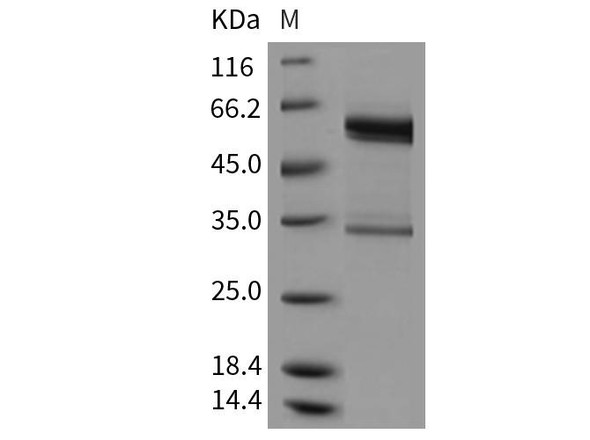Description
| Product Name: | Human tPA Recombinant Protein |
| Product Code: | RPPB2334 |
| Size: | 100µg |
| Species: | Human |
| Target: | tPA |
| Synonyms: | Tissue-type plasminogen activator, EC 3.4.21.68, tPA, t-PA, t-plasminogen activator, TPA, T-PA, DKFZp686I03148. |
| Source: | Chinese Hamster Ovary Cells (CHO) |
| Physical Appearance: | Sterile Filtered White lyophilized (freeze-dried) powder. |
| Formulation: | Each mg of t-PA contains 1.7 gr L-arginine, 0.5 gr phosphoric acid and 4 mg tween 80. |
| Solubility: | It is recommended to reconstitute the lyophilized t-PA in sterile 18M?-cm H2O not less than 100 �g/ml, which can then be further diluted to other aqueous solutions. |
| Stability: | Lyophilized t-PA although stable at room temperature for 3 weeks, should be stored desiccated below -18°C. Upon reconstitution tPA should be stored at 4°C between 2-7 days and for future use below -18°C.For long term storage it is recommended to add a carrier protein (0.1% HSA or BSA).Please prevent freeze-thaw cycles. |
| Purity: | Greater than 98.0% as determined by:(a) Analysis by RP-HPLC.(b) Analysis by SDS-PAGE. |
Tissue plasminogen activator (abbreviated PLAT or tPA) is a secreted serine proteasewhich converts the proenzymeplasminogento plasmin, a fibrinolyticenzyme. Plasminogen is synthesized as a single chain which is cleaved by PLAT into the two chain disulfide linked plasmin.This enzyme plays a role in cell migrationand tissue remodeling. Increased enzymatic activity causes hyperfibrinolysis, which manifests as excessive bleeding; decreased activity leads to hypofibrinolysiswhich can result in thrombosisor embolism.
Tissue Plasminogen Activator Human Recombinant produced in CHO cells is a single, glycosylated polypeptide chain containing 527 amino acids and having a molecular mass of 59008.71 Dalton. tPA is a serine protease enzyme that converts plasminogen to plasmin. The tPA is purified by proprietary chromatographic techniques.
| UniProt Protein Function: | Converts the abundant, but inactive, zymogen plasminogen to plasmin by hydrolyzing a single Arg-Val bond in plasminogen. By controlling plasmin-mediated proteolysis, it plays an important role in tissue remodeling and degradation, in cell migration and many other physiopathological events. Plays a direct role in facilitating neuronal migration. |
| NCBI Summary: | This gene encodes tissue-type plasminogen activator, a secreted serine protease that converts the proenzyme plasminogen to plasmin, a fibrinolytic enzyme. The encoded preproprotein is proteolytically processed by plasmin or trypsin to generate heavy and light chains. These chains associate via disulfide linkages to form the heterodimeric enzyme. This enzyme plays a role in cell migration and tissue remodeling. Increased enzymatic activity causes hyperfibrinolysis, which manifests as excessive bleeding, while decreased activity leads to hypofibrinolysis, which can result in thrombosis or embolism. Alternative splicing of this gene results in multiple transcript variants, at least one of which encodes an isoform that is proteolytically processed. [provided by RefSeq, Jan 2016] |
| UniProt Code: | P00750 |
| NCBI GenInfo Identifier: | 137119 |
| NCBI Gene ID: | 5327 |
| NCBI Accession: | P00750.1 |
| UniProt Secondary Accession: | P00750,Q15103, Q503B0, Q6PJA5, Q7Z7N2, Q86YK8, Q9BU99 Q9BZW1, A8K022, B2R8E8, |
| UniProt Related Accession: | P00750 |
| Molecular Weight: | 44,373 Da |
| NCBI Full Name: | Tissue-type plasminogen activator |
| NCBI Synonym Full Names: | plasminogen activator, tissue type |
| NCBI Official Symbol: | PLAT�� |
| NCBI Official Synonym Symbols: | TPA; T-PA�� |
| NCBI Protein Information: | tissue-type plasminogen activator |
| UniProt Protein Name: | Tissue-type plasminogen activator |
| UniProt Synonym Protein Names: | INN: Alteplase; INN: Reteplase |
| Protein Family: | Taurine--pyruvate aminotransferase |
| UniProt Gene Name: | PLAT�� |










